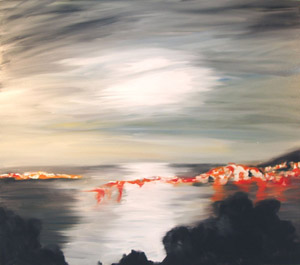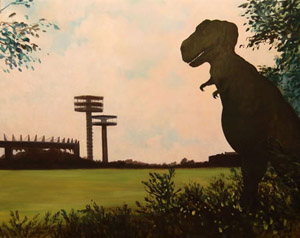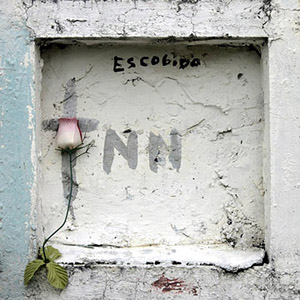The Anxious Artist
John Haberin New York City
Paul Chan, Meg Webster, and the Politics of Disaster
Writing in 1964, Harold Rosenberg called art after Warhol "the anxious object." Now anxiety is back big time, and sometimes it is even fun.
Someone once joked that the only good thing about the remake of The War of the Worlds was the destruction of Bayonne. Joy Garnett paints her own disaster movie, and Deborah Brown has the sequel, set right here in greater New York. With Paul Chan, vital memories of 9/11 blend at once into the Last Judgment and the stirrings of nature. With The 7 Lights, he turns a stifling museum interior into seven windows on the world, while putting the light itself under erasure. For Meg Webster, a well-judged Minimalism can set the artist above almost any issue you may have in mind, but the last word always goes to artists who worry about specifics. Lucien Samaha may offer a hazy unease, but he sets it in downtown Beirut. 
Jurassic New York
Between global warming, globalization, human accident, 9/11, and claims for "virtual exhibitions" after Covid-19, artists have had their fill of catastrophe lately. They can bring it home vividly all the same. In photographs, Juan Manuel Echavarría faces the drug wars in Colombia and Richard Mosse war in the Congo and refugee camps. Both connect events to the everyday lives of the victims, from grade schools to refugee camps. They also leave it to you to put a name on the dead. Yet catastrophe peeks out in less documentary form as well.
Joy Garnett packs any number of issues into just four paintings. She focuses more on the doom and gloom than on its causes. An ominous red sun stands for China's rise, but the city below seems reassuringly human in scale and fast asleep. A glowing red bridge has melted under an intensely hot sky, but perhaps only in an artist's vision, like the stranded animals in a late Turner watercolor. One scene does have sheets of flame at its center, but the canvas really about Ground Zero comes closest of all to an old-fashioned city night. All one knows for sure is that Garnett sees an apocalypse in the making—or its aftermath.
One can trace the paintings to Edvard Munch, but Garnett has few of his black outlines, little of his felt blackness, and nothing of his disturbingly heightened realism. She empties the landscapes of people and dissolves them in brushwork. The style reminds me more of the latent Romanticism in prewar American realism, perhaps John Sloan or George Bellows but with lighter primary colors. Like their work, it also delivers pleasure more than gritty reality. Her art announces the end of the world as we know it (and I feel fine). Yet it also shows a fine balance of indulgence and irony without pretense or appropriation.
After 9/11, could catastrophe strike the New York metropolitan area yet again? As if in response, Deborah Brown repopulates the outer boroughs. Birds soar and mammals cavort beneath the Bayonne and Brooklyn Bridges. The deer and the antelope play in front of an industrial skyline and the World's Fair grounds, where a dinosaur lumbers gleefully toward the New York State pavilion. After a few million years, no wonder the Philip Johnson towers stand in need of preservation. Tom McGrath maps the space of painting behind chain-link fences, but Brown is more observer than mapmaker.
She often punches up the colors as well as the action, as in her playful animal tiling for the West Houston Street IRT. Beneath the fancy, though, is a grounding in landscape. It occurs in more naturalistic paintings of Connecticut and in airier sketches, where lines and loops are in no hurry to connect.  Since I wrote this review of selected shows from 2008, Brown in fact moved entirely to abstraction—give or take her smoldering skies. And then she felt again the call to something more real, including scenes from war after older history painting and French Romanticism. I could feel her working through false steps, without losing the nexus of lines and colors on their way to cohere.
Since I wrote this review of selected shows from 2008, Brown in fact moved entirely to abstraction—give or take her smoldering skies. And then she felt again the call to something more real, including scenes from war after older history painting and French Romanticism. I could feel her working through false steps, without losing the nexus of lines and colors on their way to cohere.
For all her references to a world before humankind, I keep seeing parables of catastrophe, even beyond what critics of Andrew Moore and others have derided as disaster chic. People have vanished, but the reactors keep on smoking. Brown's environmental awareness has something in common with lush paintings of Newtown Creek by Eva Struble or Garnett's heated skies. Here, however, life insistently returns, if only to Jurassic Park. One could fault Brown, like Christoph Draeger, for trying too hard to bring conceptual sophistication to tradition—or cuddly animals to a willing public. Still, her paintings hold onto their naturalism, their optimism, and their sense of humor.
Lights out
Paul Chan takes devastation lightly. Not that he refuses to face it, as Harold Rosenberg might have been the first to admit, and the Whitney has included him in "An Incomplete History of Protest." In The 7 Lights, human silhouettes fall to their death. Dogs and chairs fly past like the debris from an explosion. In the trees, birds and leaves alike tremble. Over the course of fourteen minutes, each of the seven videos passes from morning brightness into dusk and confusion.
The lightness enters from the start, with the medium. Each projection begins with that glow, and each returns to it at the end, like a flitting ray of hope. Each mimics a window from one angle or other, and together they lighten the preposterous bulk of SANAA's boxlike architecture, with its own fear of natural light. Lightness enters, too, with the modesty of paper silhouettes in place of digital simulation. The New Museum also includes an earlier work, in which the fruit from a Caravaggio still life rise and scatter with the same comic-strip simplicity. When Kara Walker visibly manipulates silhouettes or the physically enters the Domino Sugar Refining Plant, she makes her art an act of violence, but Chan brings the soothing charm of the handmade.
Walker makes a useful point of comparison for another reason as well, her engagement with African American history. Chan, for his part, refers to everything and nothing. As with a previous work, First Light, his title derives from Christian popular fiction and its warnings of the Apocalypse. However, one cannot see crouching bodies hurtling past a window without thinking of 9/11. Carolee Schneemann outraged people quite enough when she appropriated the falling man, and she drew the line at dead dogs. I have no clue why Chan throws them in or why his installation includes a table with its dimensions borrowed from The Last Supper for feminism and new media—except perhaps that Leonardo, too, promises death and resurrection.
Chan also builds lightness into the central image, with its predominance of rising and the potential for disruption. At the 2006 Whitney Biennial, the orientation of First Light left no doubt that objects constantly rose past the utility poles. On the New Museum's Web site one can watch all seven videos, totaling nearly one and three quarter hours, and the experience is closer to a dispersal. Fuzzy silhouettes gather out of nowhere, except for some quivering rods or the massive tree, and the occasional sideways motion comes as a comic surprise. At the museum itself, the projections run simultaneously, but not in synch and from all different directions. As one video projects across that table, the light drapes like a tablecloth and onto the floor.
Chan displayed the same casual approach to catastrophe in a brilliant earlier video, which brought him attention first in the gallery and soon after at Greater New York. Its images ranged from a lynching to sneakers tossed over electric wires. They might have reduced racism and American history to a college prank, were they not so vivid and familiar. They left one to find their meaning—or to share in the shame of enjoying their cartoon colors. The 7 Lights has much the same ambivalence toward responsibility. Bloggers use the line through text to avoid responsibility for a word, while satirizing loaded language like the discredited president's like mine.
I still do not know for sure how to react to Chan's insouciance, and yet I wandered in fascination through the pools of light on a museum floor. The artist lightens disaster to the point of trivializing it, but he also invites a wider circle of empathy. When the occasional human body plummets, it still startles. The installation encourages one to wander until one has taken it all in—or until the whole issue of rising or falling seems a thing of the past. In blog-speak, a more truthful statement would follow the strikeout, and here nothing follows. Perhaps the title has no word after the strikeout because only darkness follows or only a spot of light.
Think globally
Where Chan's intimations of global catastrophe encompass lightness along with the dark, those from Meg Webster look even smaller and heavier than they are—not to mention smaller than Webster's earthworks. Even in Paula Cooper's one-room annex, they seem more than a little lost. You might struggle to imagine what they have to do with one another or with much at all. It appears a kind of Minimalism that hardly cares whether you have entered its space, but Webster very much does. She has in mind remaking something much larger than a room on 23rd Street as well.
The tiny monitor that greets one on the way in may look small in ambition. A suitably cute polar bear faces the camera, and then another bear pops up with no particular formal pattern. One might be suffering through the slide show from a persistent relative's arctic vacation. From there, things get really minimal.
A concave hemisphere sits on the floor, like an inexpensive and slightly oversized salad bowl. The same shiny metal forms a truncated cone brimming with water. The worn, white concrete square nearby could pass for painting by Robert Ryman. One could mistake the shiny black fragments in a glass column for Félix González-Torres's candy wrappers, but they do not hold out a treat.
A small, lidless box seems to hold out nothing at all. Perhaps the double layer of dull metal marks the box as its content, or perhaps they call attention to its emptiness. Their pedestal sits in front of a photograph—a black automatic weapon, barrel up against a plain white background. Clearly something ominous is at stake, but what? And is Webster able to reflect on her own tradition of purity long enough to communicate it? Is she probing the implications of a pioneering dealer's favored Minimalism or succumbing to it?
Actually, the bears are losing habitat and hungry for it. The hemisphere stands for a planet at risk, and melted weapons formed that box. As asphalt, the black fragments once leveled more of the environment, while reflecting brutal heat into a changing climate. Artists aside, people can sure do a lot of damage. Perhaps the concrete will crash to the floor, or perhaps the narrow cone will inspire a missile solo after all.
Behind their crisp and refined sensibility, these objects have inscrutable connections. That in itself need not turn anyone off, not after so many years of conceptual art, but it does raise warning flags. Webster seems indifferent to the disjunctions between source, object, image, and ends, and it never translates into shock—or into a healthy reflection on the Earth and the making of art. The arbitrary veers on nonmeaning or estheticism. In much the same way, when Karen Kilimnik places diamond dust on the wall next to kitsch painting, one knows the cost of the diamond trade, but also that girls just want to have fun. If that makes it seem awfully easy to save the bears or the planet, you have to start somewhere, and it may as well be here.
The chosen
Lucien Samaha, says his exhibition title, "is uneasy about Beirut"—as if decades of peace, love, and understanding were about to unravel. Where others might see midnight, he photographs a twilit city, and he welcomes the nostalgic as well as ominous side of twilight. Houses share their silhouettes with vegetation, ambiguously the symbol of an abandoned city or of life. They bathe in warm shadows, while clouds have an unnatural brightness amid the sunset glow. A utility pole displaces the frame for another touch of unease, but also it stabilizes a composition empty of everything but bombed-out buildings. Samaha is lying in a burned-out basement with the full moon in his eyes. 
But not a real moon, for the nostalgia extends to his pace and technique. He works constantly but needs a push to complete an exhibition. He underexposes film so that he can shoot in daylight, the cinematic technique called la nuit américaine, or day for night. The term already stood for old Hollywood memories when François Truffaut used it for his 1973 movie title. Samaha also uses a blurred focus, before processing the image digitally, adding a lumpy grain.
The results look just gorgeous enough to demand a reality check, and that is not necessarily a weakness. They have something in common with the overlaid codes on photographs of the Middle East for Barry Frydlender or Walid Raad, photos of toy soldiers by Brian Conley, and, in the 2008 Biennial, Walead Beshty. In each case, a clinical technique mixes with personal memories. The illusion of a rubbery texture also recalls Richard Artschwager in Rolotex. Again Samaha flirts with an appropriation of someone else's deliberate banality. One can accuse the artist of sentimentality, but one must also accuse oneself.
Perhaps it had to happen. So much on planet earth is taking place at once. Al Gore opposed the war in Iraq and Bush's assault on civil liberties, but he shared the Nobel peace prize instead for raising awareness of climate change. Political artists, too, require an alternative to the abstract questioning of Rem Koolhaas or the righteous anger of Sue Coe, Emory Douglas, Sarah Morris, or Hans Haacke. One can see it already in the more relaxed tone of "summer sculpture across from Ground Zero. One can see it, too, in "Unmonumental" at the New Museum, in which even Nancy Spero becomes painterly.
Every work of art has both a public and a private side. That dichotomy lends political art a special impact, reaching the anger and fears that so many share. Sure, the same dichotomy may also lead to self-righteous certainties—or to complicity and evasion. Besides, anger or fear can feed a lie, like the global war on terror or a red telephone at night. No wonder people often distrust political art, in the name of esthetic purity. No wonder, too, though, that activists and artists alike often demand it.
After years of war in Iraq and Afghanistan, two terms of Bush, consensus on global warming, and the state of the economy, is it strange that art can have mere intimations of disaster? Yet in this way it can nurture dread, loss, and mourning, without altogether excluding hope. Besides, artists are probably as tired of countering lies as the American public. One can call the result political art, but only insofar as politics extends all the way from spiritual unrest to the fate of the earth. For now, maybe anxiety will motivate the public to repudiate disaster. Clearly it can inspire artists, too.

Joy Garnett ran at Winkleman through March 29, 2008, Deborah Brown at Lesley Heller through April 26, Paul Chan at The New Museum of Contemporary Art through June 29, Meg Webster ran at Paula Cooper through March 22, and Lucien Samaha at Sara Tecchia through April 12. Brown's later work mentioned here ran at Heller through through March 9, 2014, and ongoing at Storefront Ten Eyck. Chan returns to the Guggenheim in "Artistic License" in 2019, with selections from the permanent collection.




